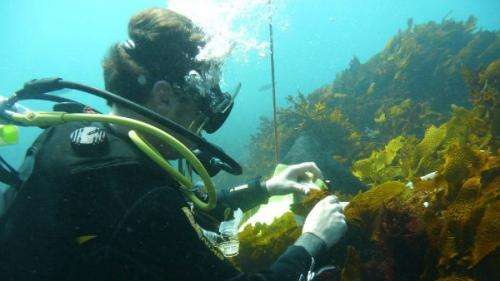Macroalgae helps to understand marine food webs

Research into macroalgae on WA reefs has revealed relationships between carbon isotope ratios and factors like temperature that may assist in the long-term monitoring of marine food webs.
The research, conducted by Edith Cowan University scientists, relates variability in carbon 13 ratios (δC13) of two species of macroalgae, Plocamium preissianum and Ecklonia radiate, to environmental factors such as dissolved inorganic carbon, light and temperature.
The ratios of carbon isotopes in producers such as macroalgae are transferred to consumers, like fish, with small and predictable increases in δC13.
These increases, of around 0.5 parts per thousand, make stable isotopes a useful tool for inferring food web interactions.
ECU Associate Professor Glenn Hyndes says this study is novel in that it identifies potential sources of variation in δC13 for certain producers on temperate reefs.
"We found that the actual values [of δC13] can be related to a range of environmental variables," he says.
The study found that temperature was strongly and positively correlated with values of δC13 in the red alga Plocamium preissianum, allowing broad spatial and temporal patterns to be predicted.
"If there is a strong relationship between stable isotopes, in this case carbon 13, then we can start to predict what might happen to those stable isotopes over time," A/Prof Hyndes says.
"We can start to incorporate some of these regional and temporal effects and be able to monitor any shifts in the stable isotopes and shifts in the food webs much more effectively."
This way, he says, as variables such as sea surface temperature change with time, we can account for the impact these variables may have on the raw isotope ratios and our interpretation of marine food webs.
A word of caution
The current study also found evidence of strong variation in the δC13 of macroalgae on WA reefs across spatial and temporal scales.
"Now we understand what that variability is, and the spatial and temporal scales they occur on, we can start to utilise the stable isotope values more effectively and start to build some confidence intervals around the averages we are basing our food web ecology around," A/Prof Hyndes says.
He says this study reinforces the necessity of questioning the assumption that stable isotope ratios are definitive and distinct from one another.
"It's a bit of a word of caution to not just go out and use other people's data and expect the values to be the same, because they do vary over spatial scales and over very small spatial scales," he says.
More information: "Physical and biogeochemical correlates of spatio-temporal variation in the δ13C of marine macroalgae, Estuarine," Coastal and Shelf Science, Volume 157, 5 May 2015, Pages 7-18, ISSN 0272-7714, dx.doi.org/10.1016/j.ecss.2014.12.040
Provided by Science Network WA

















